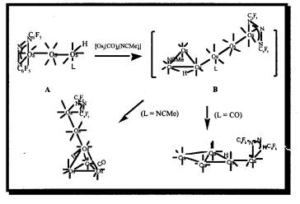D.Sc., 1985, National University of Singapore; M.A., Ph.D., 1967, Cambridge University; Ph.D., 1965, Monash University; M.Sc., 1962, University of Malaya; B.Sc., 1961, University of Malaya. Department of Chemistry, NUS 3 Science Drive 3 Singapore 117543
Contact Information:
Office: S8-03-01
Tel: (65)-6516-2662
Fax: (65)-6779-1691
Email: chmanghg@nus.edu.sg
Our research interests lie in the areas of fluorine, organometallic and cluster chemistry with special focus on synthesis, reactivity and structural studies.
The perfluoroalkyl, -aryl and -nitroxyl species have been found to display a wide range of chemical reactivity. Novel condensation reactions have led to the discovery of a new class of unsaturated inorganic molecules like:
CF3N=AsH,
CF3N=PON(CF3)2,
CF3N=GeH2
and other highly conjugated structures of P(IV) and As(IV) , hitherto unknown:
(CF3)2M=N=PPh3 M = P, As
(CF3)2P=N=P(CF3)2=N=PPh3
The structural isomers of cyclophosphines bonded to Ru and Os carbonyl clusters have been studied, using phosphorus-31 two-dimensional NMR and X-ray method.
We have found that the phosphoryl, phosphido and phosphonidene species, thermally generated, generated, can be captured by Ru and Os carbonyl clusters to afford many derivatives possessing unusual structures and bonding modes.
Linear triosmium cluster A and its analogues were found to be ideal building-blocks in the systematic synthesis of high nuclearity carbonyl clusters. Their “metal hydride coupling” reactions with clusters containing labile ligand led to “spiked” clusters B (L= CO or NCMe), were intermediates in the formation of closed clusters, and which provide the elusive evidence that have enabled the mechanism for the transformation of the “spiked” clusters to be proposed.
